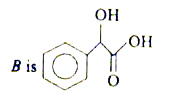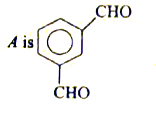Compound (A) (C8H8O) on treatment with NH2OH.HCl gives (B) and (C ). (B) and (C ) rearrange to give (D) and E, respectively, on treatment with acid. (B), (C ), (D), and (E ) are all isomers of molecular formula (C8H9NO). When (D) is boiled with alcoholic KOH, an oil (F) (C6H7N) separates out. (F) reacts rapidly with CH3COCl to give back (D). On the other hand, (E ) on boiling with alkali followed by acidification gives a white solid (G) (C7H6O2). Identify (A) to (G).
The correct Answer is:(##ALNCHMC09(II)E01652_A01##)
To solve the problem step by step, we will identify compounds A to G based on the given information and the reactions described.
Step 1: Identify Compound A
Compound A has the molecular formula C8H8O. A common compound fitting this formula is acetophenone (C6H5C(O)CH3), which has a phenyl group attached to a carbonyl group.
Step 2: Reaction with Hydroxylamine
When compound A (acetophenone) reacts with hydroxylamine hydrochloride (NH2OH.HCl), it forms oximes (B and C). The oxime formation involves the nucleophilic attack of hydroxylamine on the carbonyl carbon, leading to the formation of two geometric isomers:
- B: (E)-acetophenone oxime
- C: (Z)-acetophenone oxime
Step 3: Rearrangement to Compounds D and E
Both oximes (B and C) can rearrange upon treatment with acid to yield:
- D: An isomer of B (possibly an amide)
- E: An isomer of C (possibly another amide)
Step 4: Identify Compounds D and E
Since B and C are isomers of the formula C8H9NO, D and E must also be isomers of this formula. They could be:
- D: Acetanilide (C6H5C(O)NH2)
- E: Another isomer such as N-phenylacetamide.
Step 5: Reaction of D with Alcoholic KOH
When compound D (acetanilide) is boiled with alcoholic KOH, it undergoes dehydrohalogenation to form an oil:
- F: Aniline derivative (C6H7N).
Step 6: Reaction of F with Acetyl Chloride
The oil (F) reacts rapidly with acetyl chloride (CH3COCl) to regenerate compound D (acetanilide).
Step 7: Reaction of E with Alkali and Acidification
On the other hand, compound E (N-phenylacetamide) when boiled with alkali followed by acidification yields a white solid:
- G: Benzoic acid (C7H6O2).
Summary of Compounds
- A: Acetophenone (C6H5C(O)CH3)
- B: (E)-acetophenone oxime
- C: (Z)-acetophenone oxime
- D: Acetanilide (C6H5C(O)NH2)
- E: N-phenylacetamide
- F: Aniline derivative (C6H7N)
- G: Benzoic acid (C7H6O2)
Compound A has the molecular formula C8H8O. A common compound fitting this formula is acetophenone (C6H5C(O)CH3), which has a phenyl group attached to a carbonyl group.
When compound A (acetophenone) reacts with hydroxylamine hydrochloride (NH2OH.HCl), it forms oximes (B and C). The oxime formation involves the nucleophilic attack of hydroxylamine on the carbonyl carbon, leading to the formation of two geometric isomers:
- B: (E)-acetophenone oxime
- C: (Z)-acetophenone oxime
Both oximes (B and C) can rearrange upon treatment with acid to yield:
- D: An isomer of B (possibly an amide)
- E: An isomer of C (possibly another amide)
Since B and C are isomers of the formula C8H9NO, D and E must also be isomers of this formula. They could be:
- D: Acetanilide (C6H5C(O)NH2)
- E: Another isomer such as N-phenylacetamide.
When compound D (acetanilide) is boiled with alcoholic KOH, it undergoes dehydrohalogenation to form an oil:
- F: Aniline derivative (C6H7N).
The oil (F) reacts rapidly with acetyl chloride (CH3COCl) to regenerate compound D (acetanilide).
On the other hand, compound E (N-phenylacetamide) when boiled with alkali followed by acidification yields a white solid:
- G: Benzoic acid (C7H6O2).
- A: Acetophenone (C6H5C(O)CH3)
- B: (E)-acetophenone oxime
- C: (Z)-acetophenone oxime
- D: Acetanilide (C6H5C(O)NH2)
- E: N-phenylacetamide
- F: Aniline derivative (C6H7N)
- G: Benzoic acid (C7H6O2)
Topper's Solved these Questions
- ALKENE, ALKANE & ALKYNE Book:ALLENChapter:ALKENE, ALKANE & ALKYNE Exercise:EXCERSISE-1
Explore 25 Videos
- ALKENE, ALKANE & ALKYNE Book:ALLENChapter:ALKENE, ALKANE & ALKYNE Exercise:EXCERSISE-2
Explore 20 Videos
- ALKENE, ALKANE & ALKYNE Book:ALLENChapter:ALKENE, ALKANE & ALKYNE Exercise:EXERCISE-5[A]
Explore 68 Videos
- AIIMS 2019Book:ALLENChapter:AIIMS 2019Exercise:CHEMISTRY
Explore 40 Videos
- ALKYL AND ARYL HALIDEBook:ALLENChapter:ALKYL AND ARYL HALIDEExercise:EXERCISE-05 (B)
Explore 35 Videos
Similar Questions
A compound D(C8H10O) upon treatement with alkaline solution of iodine gives a yellow precipitate. The fibtrate on acidification gives a white solid E(C7H6O2). Write the structures of D,E .
View SolutionThe three compounds (A),(B),and (C) on hydrogenation with H2+Pd give (D),(E) and (F), respectively.

Compounds (D),(E) and (F) are :
View Solution
Knowledge Check
Compound (A) C8H6O2 on treatment with aq. NaOH followed by acidification gives (B) C3H2O3 which on oxidation gives benzoic acid only:
A B
B C
C D
D

Why does not (C) gives (D) or (D1) on treatment with alcoholic KOH or with C2H5ONa+C2H5OH?
View SolutionIn a ABC , D and E are points on the sides AB and AC respectively such that DE∣∣BC If AD=6 cm , DB=9 cm and AE=8 cm , find AC .
View SolutionAn organic compound (A) of molecular formula C5H8 when treated with Na in liquid ammonia followed by reaction with -Propyl iodide yeidls (B) C8H12 (A) gives a ketone C5H10O (e) when treated with dil H2SO4 and HgSO4 (B) on oxidation with alkaline KMnO4 gives two isomeric acids (D) and (E) C4H8O2. Give structures of compounds (A) to (E) with proper reasoning .
View SolutionCompound (A) (C6H12O2) on reduction with LiAlH4 yielded two compounds (B) and (C ). The compound (B) on oxidation gave (D), which on treatment with aqueous alkail and subsequent heating furnished (E ). The latter on catalytic hydrogenation gave (C ). The compound (D) was oxidised further to give (F) which was found to be a monobasic acid (molecular formula weight =60.0). Deduce the structures of (A), (B), (C ), (D), and (E ).
View SolutionHydrocarbon (A) C6H10 on treatment with H2,Ni,H2/Lindlar's catalyst or Na/liq. NH3 forms three different reduction products (B), (C), (D) respectively. (A) does not form any salt with ammonical AgNO3 solution, but (E) forms salt on heating with NaNH2 in an inert solvent. Compound (E) reacts with CH3I to give (F). Compound (D) on oxidative ozonolysis gives n-butanoic acid along with other product.
If (E) is reacted with acetaldehyde followed by acidification, product is
View SolutionAn organic compound (A) (C5H7OCl) reacts rapidly with ethanol to give (B) (C7H12O2). (A) also reacts with water to produce an acid which reacts with bromine to give (C ) (C5H8Br2O2). (B) on boiling with H2SO4 forms an acid (D). When (D) is oxidised with KMnO4 an acid (E ) (C4H6O3) is produced. On mild heating, (E ) gives (F) (C3H6O) which cannot be oxidised by ammoniacal AgNO3. Identify the compounds (A) to (F).
View SolutionHydrocarbon (A) C6H10 on treatment with H2Ni,H2/Lindlar's catalyst or Na/liq. NH3 forms three different reduction products (B), (C), (D) respectively. (A) does not form any salt with ammonical AgNO3 solution, but (E) forms salt on heating with NaNH2 in an inert solvent. Compound (E) reacts with CH3l to give (F). Compound (D) on oxidative ozonolysis gives n-butanoic acid along with other product.
(F) on ozonolysis will produce -
View Solution